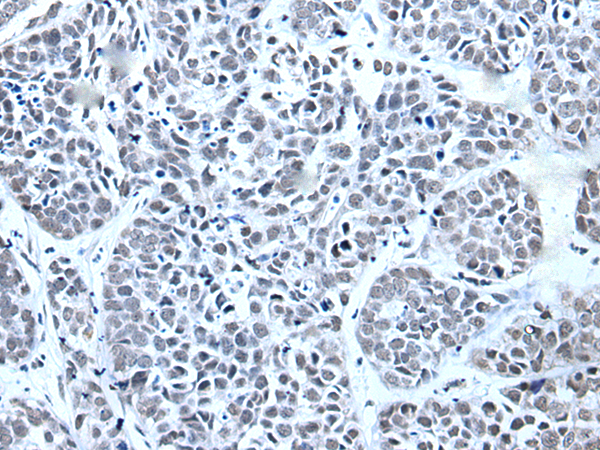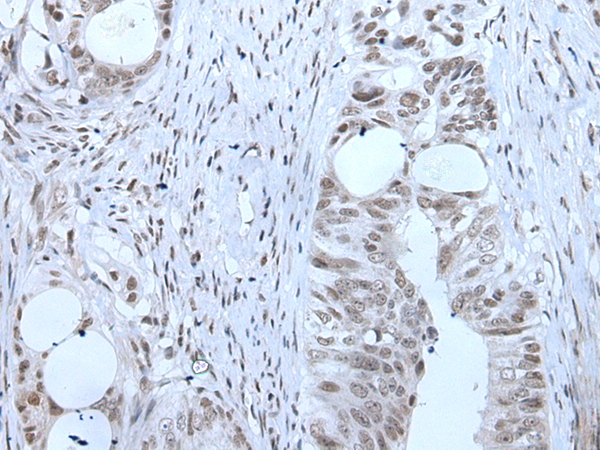

| WB | 咨询技术 | Human,Mouse,Rat |
| IF | 咨询技术 | Human,Mouse,Rat |
| IHC | 1/25-1/100 | Human,Mouse,Rat |
| ICC | 技术咨询 | Human,Mouse,Rat |
| FCM | 咨询技术 | Human,Mouse,Rat |
| Elisa | 1/1000-1/2000 | Human,Mouse,Rat |
| Aliases | XPE; DDBB; UV-DDB2 |
| Host/Isotype | Rabbit IgG |
| Antibody Type | Primary antibody |
| Storage | Store at 4°C short term. Aliquot and store at -20°C long term. Avoid freeze/thaw cycles. |
| Species Reactivity | Human, Mouse |
| Immunogen | Fusion protein of human DDB2 |
| Formulation | Purified antibody in PBS with 0.05% sodium azide and 50% glycerol. |
+ +
以下是3篇关于DDB2抗体的代表性文献及其摘要概括:
---
1. **文献名称**: "UV-induced ubiquitylation of XPC complex mediated by UV-DDB-ubiquitin ligase"
**作者**: Sugasawa, K., et al. (2005)
**摘要**: 研究揭示了UV-DDB复合物(含DDB2)在识别紫外线诱导的DNA损伤后,通过泛素化修饰XPC复合物,促进核苷酸切除修复的分子机制。文中使用DDB2抗体验证了其在损伤位点的招募。
2. **文献名称**: "The p63 protein isoform ΔNp63α modulates DDB2-mediated DNA repair in squamous cell carcinoma"
**作者**: Nichols, A.F., et al. (2012)
**摘要**: 研究发现ΔNp63α通过抑制DDB2的转录,削弱细胞对DNA损伤的修复能力,促进皮肤鳞癌发展。研究通过DDB2抗体进行免疫印迹和染色,证实其在肿瘤中的表达下调。
3. **文献名称**: "DDB2 regulates DNA replication during the cell cycle by ubiquitinating CDC6"
**作者**: Cazzalini, O., et al. (2014)
**摘要**: 提出DDB2通过泛素化降解CDC6蛋白调控细胞周期进程,揭示其修复外功能。文中利用DDB2抗体进行免疫沉淀实验,证实其与CDC6的相互作用。
---
**补充说明**:DDB2抗体常用于研究其在DNA损伤修复、细胞周期调控及癌症中的机制,上述文献均通过实验(如Western blot、免疫组化)验证了抗体可靠性。如需具体实验细节,建议查阅全文方法部分。
The DDB2 antibody targets the Damage-specific DNA-binding protein 2 (DDB2), a critical component of the nucleotide excision repair (NER) pathway involved in recognizing UV-induced DNA lesions. DDB2 forms a heterodimer with DDB1 (DDB1-DDB2 complex) to identify cyclobutane pyrimidine dimers (CPDs) and 6-4 photoproducts, facilitating their repair by recruiting downstream NER factors. Mutations in the DDB2 gene are linked to xeroderma pigmentosum (XP), a genetic disorder characterized by extreme UV sensitivity and heightened skin cancer risk. DDB2 also plays roles beyond DNA repair, including regulating apoptosis, cell cycle progression, and transcriptional activation.
Antibodies against DDB2 are widely used in research to study DNA damage response mechanisms, protein interactions, and DDB2's involvement in diseases like cancer. They enable detection of DDB2 expression levels via techniques such as Western blotting, immunofluorescence, and immunohistochemistry, aiding in investigations of its subcellular localization, post-translational modifications, and functional dynamics under stress conditions. Commercial DDB2 antibodies are available as monoclonal or polyclonal variants, often validated for specificity and sensitivity in human or murine models. Understanding DDB2's role through antibody-based assays contributes to insights into genomic stability maintenance and potential therapeutic strategies targeting DNA repair pathways.
×